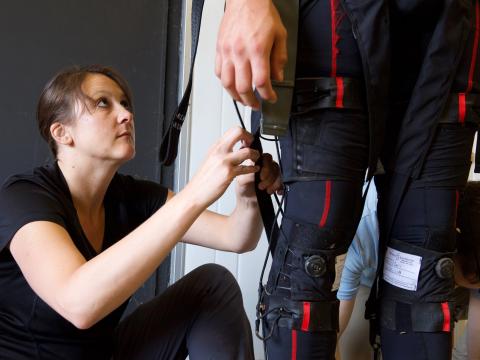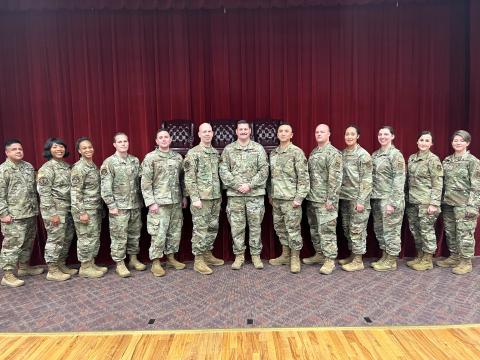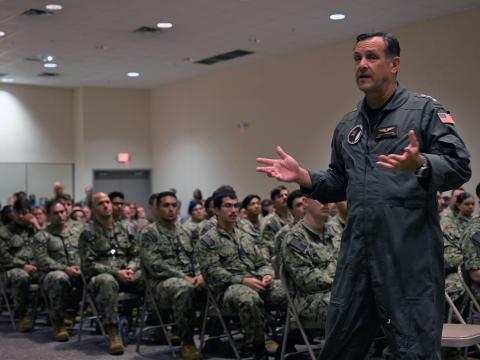Battlefield Information Systems Change With Trying Times
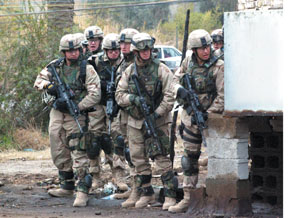 |
| A group of U.S. Army soldiers from the 82nd Airborne Division prepare to enter a compound suspected of harboring insurgents in Baghdad. The demands of urban warfare have pointed out the need for personal communications systems so that soldiers can rely on electronics, instead of on hand signals, to keep in close contact with each other as they sweep through buildings. |
Army communicators juggle many programs with a wartime urgency.
The U.S. Army is tasked with a three-sided challenge as it seeks to transform its communications-electronics systems. The Army must continue to progress with far-reaching plans that will change the way it conducts military operations; it must respond to warfighters’ urgent information technology needs in Afghanistan and Iraq; and it must incorporate changes inspired by lessons learned in those wars into its long-range efforts.
This challenge is complicated by the nature of the technology beast. Information technologies continue to evolve rapidly, and the need to insert them rapidly into the war increases the already-high degree of difficulty the Army faces in incorporating them in a timely manner. The asymmetric nature of the fighting in Iraq has elevated the call for many technologies, such as radars and sensors, currently in traditional steady-growth programs. And, many of the new capabilities that are now employed in Iraq increase in importance as a result of experiences there, which changes program priorities across the service and even in the joint arena.
One key to attaining these goals may be a recent change in the structure of the command that historically provides the impetus for new battlefield information systems. This change is designed to streamline acquisition processes while ensuring that vital programs continue efficiently through fielding to the troops.
Maj. Gen. Michael R. Mazzucchi, USA, commanding general for the Communications-Electronics Life Cycle Management Command (CELCMC) and program executive officer (PEO) for command, control and communications tactical (C3T), Fort Monmouth, New Jersey, explains that the CELCMC represents a new command structure. It includes the Communications-Electronics Command (CECOM) and the PEOs for intelligence, electronic warfare and sensors (IEW&S) and for C3T. The PEO for Enterprise Information Systems and the Communications-Electronics Research, Development and Engineering Center, or CERDEC (see page 25), are strategic partners.
Gen. Mazzucchi expresses that this change is intended to improve efficiency among the new command’s different elements. It should help bring the responsibility for specific capabilities under a single leadership—which might be a program office within the CERDEC, within a PEO or within a center of excellence. The key is that this program office would have responsibility for an acquisition across the entire spectrum of CELCMC organizations to the benefit of the warfighter and to the Army as a whole.
Having a single program office responsible for both acquisition and sustainment should speed the movement of innovations to transforming forces, the general suggests. These efforts would be synchronized and coordinated better, and troops would be better trained.
Gen. Mazzucchi points out that previous methodologies traditionally have focused on having program managers aim at transitioning a capability to the field, instead of also ensuring that a capability is sustainable and maintainable. That changes with the new approach, although not without potential snags. “We are going to have some growing pains as we figure out how to do this,” he warns. His intent is to have resource allocation sessions where all of the resources across the CELCMC can be put before the decision makers for resource decisions through a program’s entire life cycle.
Much of the incentive for this new life cycle command structure comes from requirements for supporting troops fighting in Iraq. The general notes that the command has been heavily involved in supporting the warfighter over the past three years. Last year, it was active in contracting for more than $8 billion worth of goods and services from more than 14,000 contract actions.
Many of these contract activities involved rapid responses to exigencies on the battlefield. For example, one of the biggest problems faced by U.S. forces in Iraq is to protect against improvised explosive devices, or IEDs. The general relates that the command conceived, developed and fielded some counter-IED systems in record time. These systems are designed to jam or otherwise prevent these devices from exploding. Other urgent efforts underway include developing ways to sense incoming rockets, artillery or mortar shells and then to take them out of action.
Yet, this response to warfighter needs highlights some of the challenges the command faces. One of the biggest difficulties is the issue of expanding policy requirements. Gen. Mazzucchi warns that mandates for ongoing programs conceived before the United States went to war actually hinder the implementation of new systems to address an urgent requirement in the field. He cites as examples the time limit for implementing Internet Protocol Version 6 (IPv6) and the requirement that all devices operating above the 2-gigahertz band be Joint Tactical Radio System (JTRS)-compatible. The command can obtain waivers to speed technologies and systems to the troops in combat, but it is a process, he notes.
“The fact that we have peacetime-like visions, from a policy perspective, at the same time that we are executing a war is a big challenge,” the general states. “This is one spectrum of war that is not what we thought from the perspective of stability operations.”
Many differences have arisen between the goals of long-term programs and the urgent needs of Iraq combatants. Gen. Mazzucchi explains that, while Army programs of record must continue and achieve their goals for supporting the warfighter, most of the solutions that the command is working on for Iraq are specific to that theater. “We cannot forget that there are other requirements in addition to just what we’re engaged in right now,” he points out.
The command must do a better job of articulating the transition from current force systems capabilities to long-term programs such as Future Combat Systems (FCS), the general adds. “Both [JTRS and FCS] will be in existence for some period of time, and we will face the backward/forward, compatibility/interoperability dynamic challenge at the same time that we are continuing to modify both,” he says. “As soon as we make a decision in one area, something happens in another that negates that decision. It is a tremendously challenging feedback-loop, decision-making process because nothing stays still long enough.
“The rate of change is accelerating, and it is even more of a challenge in the C4ISR [command, control, communications, computers, intelligence, surveillance and reconnaissance] world because the technology changes so much faster,” the general states.
The general continues that the acquisition process needs a revisit, especially in the areas of requirements, resourcing and development. Some aspects have changed because of wartime demands that mandate immediate action, but these are exceptions rather than the rule and the original process remains in place. “Sometimes we find ourselves working multiple sets of requirements,” he relates.
Some changes have taken place on the fly. In the summer of 2002, before going into Iraq, the Army was planning a gateway test for four major Army Battle Command systems and their associated systems. These were to undergo an operational test that the general describes as one of the most comprehensive Army Battle Command and networking tests ever conducted. Then, the Army outfitted its diverse combat formations based on those system-of-systems tests. These units differed in their high-technology nature to great degrees, and planners had to assess each unit’s system architecture to determine how they should be equipped and trained the units. Many battle command systems had to be fielded in spite of the fact that they had not been through formal operational testing.
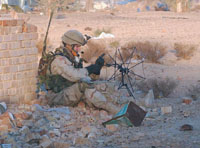 |
| A paratrooper with the 82nd Airborne Division sets up a satellite radio during a patrol in Fallujah, Iraq. The U.S. Army is working to speed new communications-electronics technologies into Iraq and Afghanistan as it advances many transformational programs. |
Gen. Mazzucchi describes this as a major conceptual acquisition strategy change, noting that the Army had plans for successive versions of increasing capabilities from threshold to objective across all of the requirements documents. Instead, the acquisition strategy was turned upside down because of the successful prosecution of the Iraq War.
The ramifications were felt beyond the Army Battle Command systems. With the Army now at war, it’s focus is on obtaining the most capability quickly. So, as requirements and operational needs statements come in from combatant commanders, the Army modifies current systems as needed. Transformational programs such as FCS do not spiral capabilities incrementally into the force as easily as other programs can.
However, some current systems can be modified to meet these needs. So, the Army is seeing more of a blending of capabilities as opposed to a “big bang” system introduction approach across the force.
Some elements of the technology base have taken a foothold, Gen. Mazzucchi observes. The Command Post of the Future, a Defense Advanced Research Projects Agency (DARPA) effort, took a bottom-up look at how to provide a comprehensive view of the war in a collaborative environment. This went far beyond traditional whiteboard presentations, the general relates, by converting virtually all of the command post functions—including voice conferencing—into digital format. Advances spawned by this program have entered the force in Iraq, and this in turn has lessened the desire for videoconferencing in that theater. Reducing the use of that capability in turn has lessened the demand for bandwidth. The general notes that once this concept is validated, it will become part of the Army Battle Command program of record.
To improve battle command on-the-move capabilities, industry is pitching in with its own independent research and development to develop workable solutions, the general notes. And, technologies such as tracking antennas, networking protocols and applications with extensible markup language (XML) all are FCS visionary protocols that are being inserted into the current force.
Some of these advances are having considerable effect in the joint arena. Gen. Mazzucchi relates that when Joint Requirements Oversight Committee (JROC) officials noted the successes of battle command items such as Blue Force Tracking and, U.S. Marine Corps C2 PCs, they began to push for more synergy among these systems in the services. So, the transformational program in battle command aims at two command areas. For echelons at brigade and above, it will focus on the C2 PC evolving to the Global Command and Control System as a single capability across the forces. For brigade and below, the trend will be toward Force XXI Battle Command Brigade and Below (FBCB2)/Blue Force Tracking. When each of the two services refreshes its technology, it will emulate the system of the other service.
The insurgency in Iraq has highlighted the need for new communications systems to deal with urban warfare. When a soldier exits a Stryker or a Bradley fighting vehicle, he must resort to hand and arm signals if he is to communicate without using his voice. “We can and must do better tying together that soldier network,” Gen. Mazzucchi declares.
“From a networking perspective, we are just drinking from a water hose now,” the general analogizes. “We would like to have a fire hose turned on with all kinds of solutions.”
Antenna technologies are high on the command’s list of needed technologies. The introduction of JTRS with its 32 different waveforms offers the potential of turning each JTRS-equipped vehicle into an antenna farm. “I saw the test vehicle, and it looked like a porcupine,” the general allows. The many frequency ranges generate the need for several different kinds of antennas, and consolidating these would reduce that footprint.
ISR is encountering new applications with the asymmetric threats in Iraq. Gen. Mazzucchi relates how when U.S. forces counter one type of threat, the enemy finds a way to counter the U.S. counter. Staying one step ahead of the insurgency involves considerable work with ISR technologies, he notes.
Persistent surveillance technologies also loom large in the Army’s future. Gen. Mazzucchi cites the need to view and understand the battlefield situation around the clock, which is important for force protection issues.
With the Army shifting its voice/video/data transfer to Internet protocol (IP), it will need new IP technologies. The general notes that signaleers often must instruct a commanding general on how to modify operational plans based on signaleers’ ability to build on the network. Using modern protocols and server algorithms will help make the network transparent to the operational plan and to the warfighter.
And, a simple matter such as the address book poses not so simple challenges. Everyone in a particular formation must know the IP and addresses of each other. Updating this information for individual movements can be a problem. The general notes that this addressing currently is done a priori, but forces would be better served if it could be done dynamically.
Ultimately, the soldier on the battlefield should have situational awareness 100 percent of the time, the general declares. This would entail giving that soldier a true understanding of where he is, where his colleagues and command structure are, and where the threat is. Achieving this goal will help reduce the fog of war that still exists, especially in urban warfare. Instead of soldiers continuing to use hand signals, the Army wants to provide them with the same capabilities that exist in the tactical operations center, Gen. Mazzucchi warrants.
Web Resources
CECOM: www.monmouth.army.mil/cecom/cecom.html
Fort Monmouth/Team C4ISR: www.monmouth.army.mil/C4ISR
PEO C3T: http://peoc3t.monmouth.army.mil
